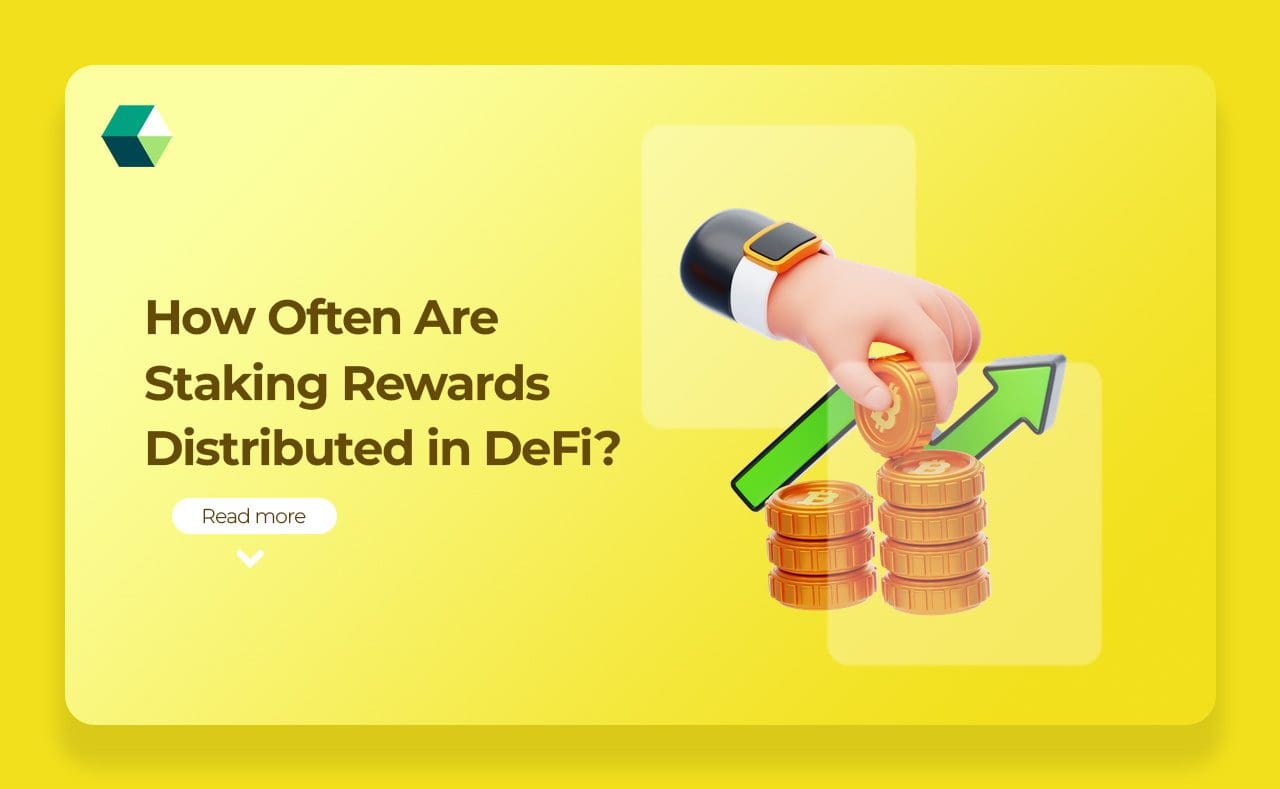
Staking has become a popular method of earning passive income through cryptocurrency. It involves locking up a certain amount of tokens in a staking protocol to support the network’s operations, such as transaction validation or liquidity provision, and in return, stakers receive rewards. One common question among both novice and seasoned investors is: How often are staking rewards distributed in DeFi? This blog post will explore the various factors that influence the frequency of staking reward distributions, delve into different staking models, and provide insights into how staking works within the broader DeFi ecosystem.
What Are DeFi Staking Rewards?
DeFi staking rewards refer to the incentives earned by individuals who lock up their cryptocurrency assets in Decentralized Finance (DeFi) Protocols to support various network functions, such as validating transactions, providing liquidity, or participating in governance. By staking their tokens, users contribute to the stability and efficiency of DeFi platforms, which often results in the distribution of rewards as compensation. These rewards typically come in the form of additional tokens or yield generated from interest or transaction fees. The amount and frequency of rewards can vary based on the staking model, protocol performance, and overall market conditions. DeFi Staking Rewards offer an attractive way for participants to earn passive income while supporting the decentralized ecosystem.
Why Are Staking Rewards Important in DeFi Protocols?
Staking rewards are crucial in DeFi protocols because they incentivize users to actively participate in maintaining and securing the decentralized network. By offering rewards, DeFi platforms encourage users to lock up their assets, which supports essential functions such as liquidity provision, transaction validation, and network governance. This not only enhances the stability and efficiency of the protocol but also fosters community engagement and trust. Staking rewards help align the interests of participants with the long-term success of the platform, as users benefit directly from their contributions. Moreover, these rewards contribute to the overall growth and sustainability of the DeFi ecosystem by attracting more participants and capital, driving innovation, and supporting the development of new decentralized applications and services.
How Often Are Staking Rewards Distributed in DeFi?
In Decentralized Finance (DeFi), the frequency of staking reward distributions can significantly impact the experience and strategies of participants. The distribution schedule varies depending on the protocol, its design, and the staking model in use. Here’s a more detailed look at the different distribution frequencies and what they mean for users:
-
Daily Distributions
Daily reward distributions are common in many DeFi platforms, especially those focused on liquidity provision and yield farming. This frequent payout structure allows users to receive rewards every day, providing regular feedback on their staking performance. For instance, liquidity providers on decentralized exchanges (DEXs) might receive daily rewards from transaction fees and incentive programs. This frequent distribution can be advantageous for those looking to reinvest their earnings quickly to take advantage of compounding returns. Daily distributions also help in maintaining user engagement, as participants can see the immediate impact of their staking activities.
-
Weekly Distributions
Weekly distributions strike a balance between regular payouts and operational efficiency. Many DeFi platforms that use staking pools or yield farming strategies adopt this schedule. By aggregating rewards over a week, platforms reduce the frequency of administrative tasks and transaction fees associated with each payout. For users, weekly distributions provide a predictable schedule while still allowing for relatively frequent updates on their staking performance. This method is often used by platforms that handle larger volumes of transactions or require more complex reward calculations.
-
Monthly Distributions
Monthly distributions are less frequent but are used by some DeFi protocols due to the nature of their operations or the scale of their reward systems. This schedule can be beneficial for protocols that manage large amounts of staked assets or have complex reward mechanisms. For users, monthly payouts provide a longer-term view of their staking rewards and may align with broader financial planning or investment strategies. However, this less frequent distribution might result in a slower accumulation of rewards, which can affect the compounding potential.
-
Epoch-Based Distributions
Epoch-based distributions are tied to specific periods defined by the protocol, often referred to as epochs. For example, Cardano’s staking rewards are distributed roughly every five days, corresponding with its epoch structure. This method provides a regular and predictable reward schedule, aligning with the network’s operational cycles. Epoch-based distributions can simplify reward calculations and make it easier for participants to track their earnings over time.
-
Event-Driven Distributions
Some DeFi protocols use event-driven distributions, where rewards are distributed based on specific events or milestones. This could include reaching a certain staking threshold, the completion of a network upgrade, or other significant occurrences within the protocol. Event-driven distributions can introduce variability in reward payouts, potentially affecting how users plan their staking activities. While this approach can align rewards with significant protocol developments, it may also lead to less predictable income streams.
How Can I Earn Cryptocurrency Staking in DeFi?
Earning Cryptocurrency Staking rewards in DeFi involves participating in decentralized finance protocols by locking up your assets to support the network’s operations or liquidity needs. To get started, you first need to select a DeFi platform that offers staking opportunities, such as Decentralized Exchanges (DEXs) or lending platforms. Once you’ve chosen a platform, you’ll need to deposit your cryptocurrency into a staking contract or liquidity pool. Depending on the platform, you might stake directly on the blockchain network, provide liquidity to trading pairs, or participate in yield farming. In return for your participation, you’ll earn rewards, which are typically distributed periodically and can include additional tokens or a share of transaction fees. It’s important to understand the specific staking terms, reward structures, and potential risks associated with each DeFi protocol to optimize your earnings and safeguard your investments.
How Do I Choose the Best DeFi Staking Opportunities?
Choosing the best DeFi staking opportunities involves a careful evaluation of several key factors to ensure optimal returns and minimal risks. Start by assessing the staking rewards offered by different protocols, including the reward rate and distribution frequency. Higher rewards can be attractive, but they often come with higher risks. It’s essential to understand the underlying DeFi protocols and their mechanisms, such as the reliability and security of the platform, and the transparency of its reward structures. Evaluate the protocol’s liquidity and total value locked (TVL) to gauge its stability and market confidence.
Additionally, consider the vesting period and lock-up requirements, as some opportunities may require you to lock your assets for extended periods. Research the protocol’s track record and community feedback to ensure it has a solid reputation and is not subject to frequent issues or vulnerabilities. Lastly, diversify your staking investments to spread risk across different assets and protocols. By taking these factors into account, you can make informed decisions and choose DeFi staking opportunities that align with your investment goals and risk tolerance.
Which is the Best DeFi Staking Platform?
Choosing the best DeFi Staking Platform requires a comprehensive evaluation of various factors to ensure that the platform aligns with your financial goals, risk tolerance, and investment preferences. Here’s an in-depth look at some of the top DeFi staking platforms and what you should consider when selecting the best one for your needs:
-
Aave
Aave is a decentralized lending protocol that provides opportunities for staking its native AAVE tokens. Users who stake AAVE can participate in governance decisions and earn rewards for supporting the network. Aave is well-known for its strong security protocols, innovative features such as flash loans, and its large and active user base. The platform offers both single-sided staking and liquidity provision, allowing users flexibility in how they engage with the protocol. The robustness of Aave’s infrastructure and its proven track record make it a highly reliable choice for DeFi staking.
-
Uniswap
Uniswap is a leading decentralized exchange (DEX) that facilitates automated token swaps and liquidity provision. Staking on Uniswap involves providing liquidity to trading pairs and earning rewards through transaction fees. Users receive liquidity provider (LP) tokens as proof of their contribution, which can be staked to earn additional incentives. Uniswap’s extensive liquidity and high trading volume contribute to potentially lucrative staking opportunities. Its decentralized nature and the ability to stake various token pairs make it a versatile option for users looking to participate in DeFi.
-
Compound
Compound is another prominent DeFi lending protocol that offers staking through its native COMP tokens. Users can earn COMP by participating in the governance of the protocol and by providing liquidity to the lending pools. Compound is known for its user-friendly interface, efficient lending and borrowing mechanisms, and strong security measures. The platform allows users to manage their assets and staking activities with ease, making it a favorable choice for both novice and experienced DeFi participants.
-
PancakeSwap
PancakeSwap operates on the Binance Smart Chain (BSC) and is a popular DEX offering various staking opportunities through its native CAKE token. Users can stake CAKE to earn rewards from transaction fees and participate in yield farming. PancakeSwap’s lower transaction fees compared to Ethereum-based platforms and its fast processing times make it an attractive option for users seeking efficient and cost-effective staking. The platform’s growing ecosystem and incentives for liquidity providers add to its appeal.
-
Yearn.Finance
Yearn.Finance is a yield optimization platform that allows users to stake their assets across various DeFi protocols through its vaults. By leveraging sophisticated yield farming strategies, Yearn.Finance aims to maximize returns for its users. The platform’s automated investment strategies and diverse range of investment options make it a compelling choice for those looking to optimize their staking rewards. Yearn.Finance’s innovative approach and its focus on yield maximization provide users with an advanced tool for DeFi staking.
-
Curve Finance
Curve Finance specializes in stablecoin swaps and liquidity provision. The platform’s focus on stablecoins allows users to stake assets in liquidity pools and earn rewards from trading fees and additional incentives. Curve’s design minimizes slippage for stablecoin transactions, making it an attractive option for stablecoin liquidity providers. The platform’s efficiency in stablecoin trading and its strong community support contribute to its reputation as a reliable DeFi staking platform.
-
SushiSwap
SushiSwap is a decentralized exchange that provides various staking opportunities, including liquidity provision and yield farming. Users can earn rewards from transaction fees and additional incentives by staking its native SUSHI token. SushiSwap’s emphasis on community governance, innovative features like SushiBar staking, and its continuous development efforts make it a noteworthy choice for DeFi participants. The platform’s focus on rewarding its community and enhancing user experience adds to its appeal.
What are the Risks Associated with Staking in DeFi?
Staking in DeFi carries several risks that participants should be aware of before committing their assets. One significant risk is smart contract vulnerability, where bugs or exploits in the code can lead to loss of funds or security breaches. Decentralized Finance Protocols , being open-source, are subject to scrutiny and potential attacks, making rigorous code audits and security measures crucial. Liquidity risk is another concern; if a platform experiences high volatility or a sudden drop in liquidity, it can affect the value of staked assets or make it difficult to withdraw them. Impermanent loss occurs when providing liquidity to trading pairs, particularly in volatile markets, where the value of the staked tokens may decrease relative to holding them outright.
Additionally, platform risk involves the possibility of the DeFi protocol itself facing operational issues, such as governance disputes, management failures, or even insolvency. Regulatory risk is also emerging as a factor, as changes in regulatory frameworks could impact the legality and operation of DeFi platforms. Lastly, rewards volatility can result from fluctuations in the reward rates and the underlying assets’ value, making staking returns unpredictable. Understanding these risks and conducting thorough research can help mitigate potential issues and make informed decisions when participating in DeFi staking.
What Makes Nadcab Labs Good for DeFi Staking?
Nadcab Labs stands out in the DeFi staking space due to its comprehensive and innovative approach to DeFi solutions. The company offers a robust suite of services that enhances the security, efficiency, and user experience of staking protocols. Nadcab Labs provides advanced security measures and regular audits to ensure that smart contracts are resilient against vulnerabilities and exploits, addressing a significant concern in DeFi staking. Their expertise in developing scalable and efficient blockchain solutions ensures that staking platforms can handle high volumes and maintain liquidity without compromising performance.
Additionally, Nadcab Labs focuses on user-friendly interfaces and seamless integration, making it easier for participants to engage with staking opportunities. The company’s commitment to continuous development and innovation means they stay ahead of emerging trends and risks, providing clients with up-to-date and cutting-edge solutions. By leveraging Nadcab Labs’ services, DeFi projects can offer secure, reliable, and efficient staking options, ultimately contributing to a more robust and user-centric DeFi ecosystem.






